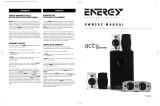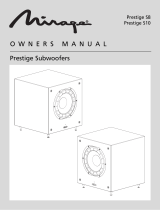owners manual
C-R100
The rear speakers can vary greatly in position depending on the room layout,
and the furniture placement.The ideal position is either on the side walls, or
rear walls.
Side Wall: This position utilizes the rear walls of the room to reflect sound and
create the "surround" effect.
Rear Wall: This is generally used when the side wall position is not available to
you, due to furniture placement or room dimensions. It is also used in a 6.1 or
7.1 surround configuration.
Both mounting positions have their advantages and disadvantages, the position
offering the best coverage of the entire room should be chosen.The goal of the
surround speakers during movie reproduction is to create an "atmosphere"
around you.The rear channel speakers are ideally placed an equal distance from
you as compared to the front speakers. But this is not always possible in a
home environment.The C-R100 will emit sound from both sides of the speaker,
and is best placed where it can use the walls to reflect the sound around the
listeners.The best mounting position for a 5.1 system is the Side Wall position,
as it makes use of the rooms' rear walls, and side walls. It will create a lifelike
surround effect and make the room sound larger than it is. In this position, try
to mount the speaker so that it is beside you or slightly behind you.The height
should be above ear level, at approximately 2/3 of the height of the wall.6 feet
off of the ground is typically a good starting point, and the speaker should be 2
feet above your head when seated.These general guidelines should aid in
positioning choices. Please see diagram 9.
You can also achieve excellent results in the rear position.Try not to place the
speakers directly into a corner. Leave 2 or more feet between the edge of the
cabinet and the side wall,so the sound can reflect into the room environment.
The rear position is usually chosen when your room will not accommodate the
side wall position due to unequal walls, a doorway, or a large opening,etc.It is
recommended that the rear center (6.1 system) or dual rear surrounds (7.1) be
placed at the same height as the other two rear surround speakers wherever
possible.
MOUNTING YOUR C-R100 SPEAKERS
NOTE:The C-R100 features a very simple wall mounting system.Careful
attention must be made to mount it securely as the speaker is heavy and
damage to the product and/or injury could result from improper mounting.
Please follow the directions carefully! Please see diagram 10.
1) Select the mounting position best suited for your room.
2) Place the wall mounting bracket against the wall in the desired mounting
location and mark the center of the two holes with a pencil.This is where
you need to insert the appropriate mounting hardware to securely fasten a
load of 15 lbs. Hardware is not included with the speaker, as building
materials vary greatly in different countries, but the recommended screw
head size is a #8. Screw length is to be determined by the wall material.
3) If you are mounting directly to drywall,please ensure that you use the
appropriate anchors, as screws into drywall itself will not provide a secure
mount. Insert the anchors, and then hold the mounting bracket up to the
wall.Insert the screws until tight.Try to locate into wall studs wherever
possible.
4) Screw the included bolt into the insert in the back of the C-R100 speaker,
located above the terminal cup. Hand tighten the bolt all the way, and then
loosen a few turns counter clockwise. Place the two included rubber bumpers
on the back of the speaker, on either side of the back label.
5) Hold the speaker upright, and insert the bolt head into the large hole. Let the
speaker slide down into place.
FINE TUNING
Before beginning any fine tuning, please ensure all connections are properly
made and your speakers have had the chance to break-in for a minimum of
100 hours.This will ensure the proper results are achieved.
Your listening room is the final component of your audio system and will be the
difference between mediocre sound and high quality sound. Reflections, which
are a part of every recording and music playback, will have a major effect on
your system's performance. If your room is too “live”, meaning there are many
bare surfaces like glass windows, hard floors and thin furnishings, you might
find the sound overly bright. If your room is “dead”, meaning there is thick pile
carpeting, heavy furniture and a lot of wall coverings, you might find the sound
lacks dynamic energy.To remedy these issues, small changes to your room
should be considered as they generally lead to large improvements in sound
quality. Most listening rooms must balance aesthetics and sound, but patience
and small adjustments in positioning and settings can pay huge acoustic
dividends.
The lower bass frequencies are typically the most influenced by your listening
room. If you find the bass in your room to be uneven or exaggerated in certain
frequencies, experimenting with placement of the front speakers or their
orientation towards the listening position can alleviate some of these issues.
The proximity of the speakers to room boundaries, like walls, will also affect the
bass frequencies. If you find your system lacks bass, first check your
connections to make sure your system is in phase, then experiment with
placement.The further from the wall,the less overall bass output your system
will have, but the bass will generally be better defined.If you position your
speakers too close to a room boundary, the bass will typically be exaggerated
and ill-defined.Adjusting your speakers to your room will generate the best
results.
If you are experiencing issues with imaging, first ensure your speakers are in
phase with each other. If this is the case and imaging is still an issue, moving
the speakers closer together or toeing them in slightly (angling them towards
the listening position) can aid in this respect.
When installing a surround sound system, all the above holds true. Calibration
of your speaker distances, adjusting delays and balancing your levels with an
SPL meter are necessary to extract the most out of your system.
CARE OF FINISH
The C-Series cabinets should be gently cleaned with only a damp cloth and
warm water from time to time, in order to remove any dust or fingerprints. Do
not use an abrasive cleaner, or any type of ammonia based cleaners, or window
type cleaners.To remove the dust from the grille cloth, use the brush
attachment on your vacuum cleaner or a slightly dampened sponge or dust free
cloth. Do not touch the speaker cones directly or enter them in contact with
water or cleaning materials, as this can cause irreparable damage.
4















